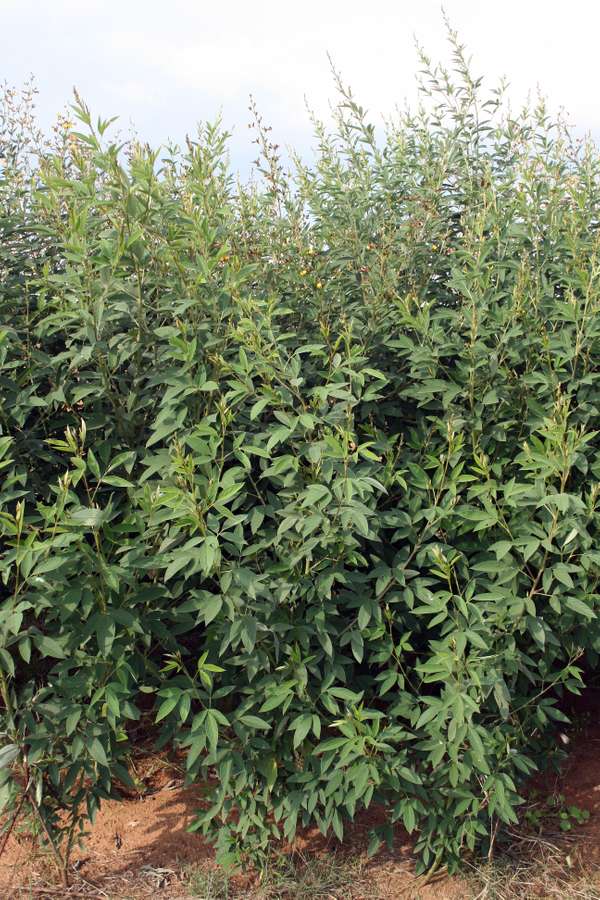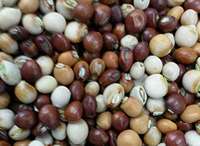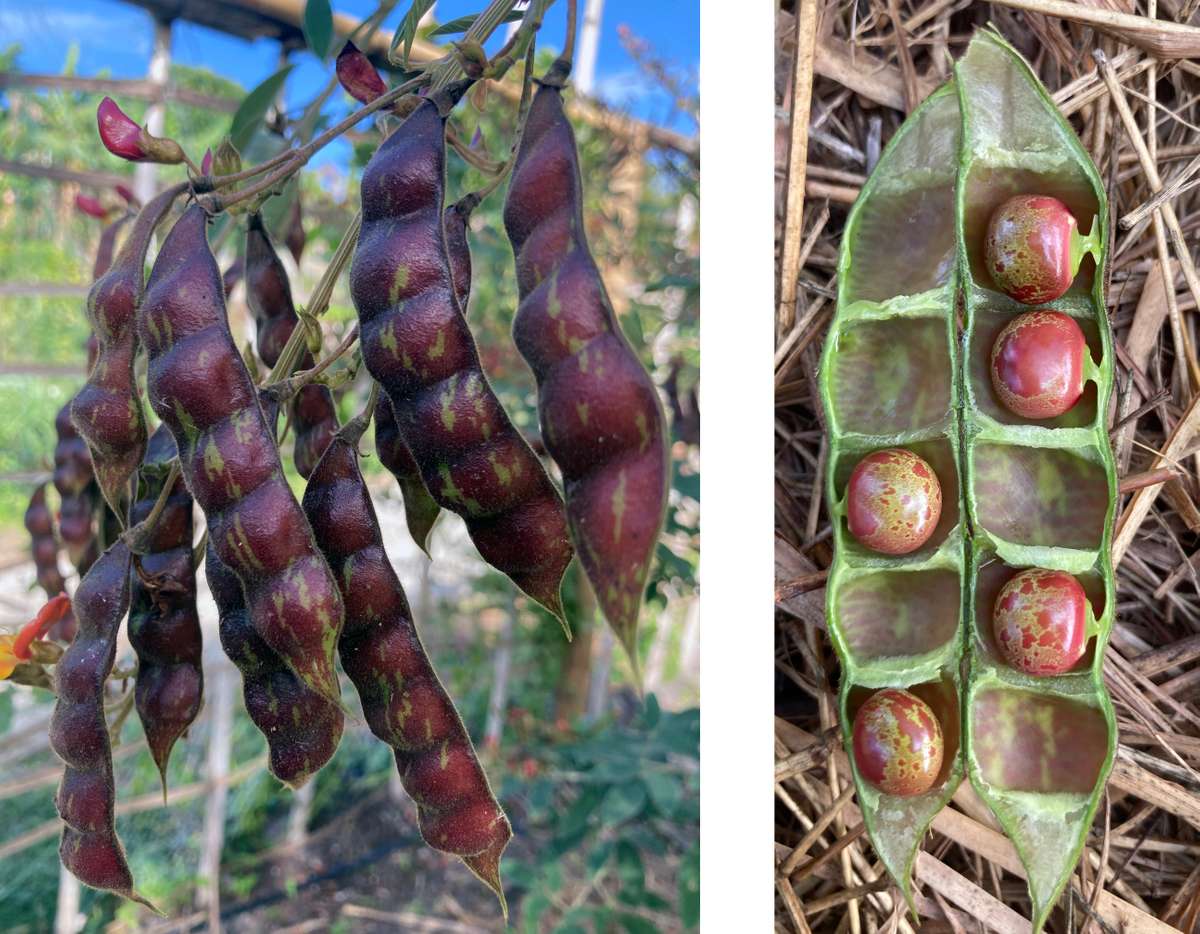Benefits of pigeon pea
Pigeon pea (Cajanus cajan) is a multi-use legume well suited to rainfed agriculture in hot, dry areas. Pigeon pea plants grow into erect (1-4 m tall) shrubs (Figure 2) that can live up to five years, though pigeon pea is usually grown for only one or two years. Edible, nutritious seeds, 3 produced in pods, can be made into a variety of foods. In India, a thick stew called dahl is made from dry, split seeds with the seed coat removed (Singh, 1995). Pods and seeds can be collected at an immature/green stage and cooked as a vegetable. Other parts of the plant are also useful; leaves can be fed to animals, and dry stems serve as fuel for starting cooking fires.
Pigeon pea grows well in poor soils. It belongs to the legume (Fabaceae) family of plants of which many members, in association with bacteria that colonize the roots, convert atmospheric nitrogen into a form that plants can use. This means pigeon pea plants do not need as much soil nitrogen as crops like maize. Nitrogen obtained from the air and incorporated into pigeon pea plants will be added to the soil when the plants die, as long as the residue is kept in the field. Additionally, pigeon pea’s deep roots grow through hard layers of soil (called hard pans), improving water infiltration and soil aeration (Arihara et al., 1991). These soil improvements benefit crops that are planted with and/or after pigeon pea.
Many varieties of pigeon pea are available. In the remainder of this article, we summarize varietal differences and mention some farmers’ preferences. These considerations can be helpful when selecting seeds, whether from ECHO or elsewhere.

Figure 2. Pigeon pea plants growing in dry, sandy soil. Source: Tim Motis
Varietal differences
Duration
Pigeon pea varieties are labeled as short-, medium-, or long-duration, depending on how long (after seeds are sown) the plants flower or the pods reach maturity (Table 5).
| Table 5. Grouping of pigeon pea varieties based on how many days (from the time seeds are planted) it takes for half of the plants to flower or for most of the pods to mature. | |||
|---|---|---|---|
| Maturity category | Days to 50% floweringZ | Days to pod maturityZ | Varieties in ECHO's seed bank |
| Short | 106 | <150 | ’Georgia-1’, ‘Georgia-2’, and ‘ICPL 88034’ |
| Medium | 123 | 151-180 | |
| Long | 144 | >180 | ‘Agroforestry Select’, ‘Caqui’, ‘ICPL 8151’ |
| ZData from Egbe and Vange (2008), who cite Reddy (1990) as the source for days to pod maturity ranges. Nyirenda Yohane et al. (2020) measured days to maturity as days from seeding until 75% of the pods in a plot turned brown. | |||
Traditional pigeon pea varieties tend to be medium- and long-duration types. These varieties will have deeper roots and larger plants (with more biomass for soil mulch) than short-duration varieties. Most medium- and long-duration varieties are ‘indeterminate,’ meaning that growth continues after flowering. Many short-duration varieties, on the other hand, are ‘determinate’ and stop growing after they flower. Indeterminate varieties tend to grow taller and produce pods over a longer period; this makes them especially desirable for household use. For field planting, determinate varieties that produce pods on a compact plant within a short window of time are easier to harvest. Short-duration types have been an important focus of breeding efforts (e.g., by ICRISAT [http://edn.link/2mg7y4]) in recent decades. Their early seed production gives an important advantage in regions with short rainy seasons.
Sensitivity to day length
Medium- or long-duration varieties typically require short days (12-13 hours) to flower (Carberry et al., 2001), which means these varieties can only be harvested during the time of year with shorter days. Short-duration varieties offer farmers greater flexibility—for example, they can time their plantings so that they have grain to sell when they can get the best return on investment.

Figure 3. Various colors of dry pigeon pea seeds. Source: ECHO staff
Seed color and size
Pigeon pea seed colors include black, brown, purple, or white (Figure 3). Some are uniform in color while others are speckled. Pigeon pea seed size is described in terms of weight per 100 seeds. The 100-seed weight ranges from 4 to 24 g between pigeon pea varieties (Narayanan et al., 1981).
Vegetable versus pulse
While pigeon pea is usually grown for its dry beans (pulse), pods of some varieties are harvested early (before drying on the plant) and consumed as a vegetable (Figure 4). ECHO’s seed bank carries a purple vegetable type called ‘ICP 7035’.

Figure 4. Example of pigeon pea pods (left) and seeds (right) picked at full size while still fresh, to be cooked and eaten as a vegetable. Source: Tim Motis
Farmer preferences
Many factors influence which varieties farmers choose to grow. These factors include cultural preferences, taste, visual appearance, cooking time, growing constraints, and seed availability. A study in Malawi showed that farmers preferred varieties with white/cream seeds, which they felt had good cooking quality (Nyirenda Yohane et al., 2020).4
For vegetable varieties of pigeon pea, long pods, large seed size, and sweetness are preferable traits (Saxena et al., 2010). The ‘ICP 7035’ variety [available from ECHO’s seed bank] has a sugar content of up to 8.8%, quite a bit higher than the 5% sugar content of most vegetable varieties (Saxena et al., 2010).
Seeds that cook quickly require less food preparation time and less firewood. Farmers in Benin identified this as an important trait (Ayenan et al., 2017). Jambunathan and Singh (1981) reported an inverse relationship between cooking time and seed weight, and between cooking time and water absorption. Apparently, large seeds took less time to cook than small seeds because their seed coats allowed for faster absorption of water.
Sometimes farmers choose varieties that enable them to avoid or minimize pest problems. Pod borers (Helicoverpa sp.) are a pest on pigeon pea plants. Farmers in India were interested in varieties with resistance to pod borers, and some grew a variety called ‘Durga’ that flowers and produces pods before borer populations peak (Singh et al., 2020). [Pod borer larvae can also be shaken off the plants and collected on a sheet; Berkelaar, 2004].
Closing thoughts
Farmers may already be growing pigeon pea in your region/country. Before promoting pigeon pea, find out what varieties farmers grow and how pigeon pea products are used. Valuing local varieties keeps them from disappearing and, thus, helps preserve the genetic diversity of the crop. If the community expresses an interest in or need for other varieties, consider the factors mentioned in this article when selecting varieties to evaluate within your context. Browse the ECHO Online Seed Catalog [http://edn.link/seeds] to see what varieties we carry and how to obtain trial packets of seeds.
References
Arihara, J., N. Ae, and K. Okada. 1991. Root development of pigeonpea and chickpea and its significance in different cropping systems. In: ICRISAT (International Crops Research Institute for the Semi-Arid Tropics). 1991. Phosphorus Nutrition of Grain Legumes in the Semi-Arid Tropics. (Johanson, C., K.K. Lee, and K.L. Sahrawat, eds) pages 183-194.
Ayenan, M.A.T., K. Ofori, L.E. Ahoton, and A. Danquah. 2017. Pigeonpea [(Cajanus cajan (L.) Millsp.)] production system, farmers’ preferred traits and implications for variety development and introduction in Benin. Agriculture and Food Security 6(1):48.
Berkelaar, D. 2004. Pick those podborers. ECHO Development Notes 84:4.
Carberry, P.S., R. Ranganathan, L.J. Reddy, Y.S. Chauhan, and M.J. Robertson. 2001. Predicting growth and development of pigeonpea: flowering response to photoperiod. Field Crops Research 69(2):151-162.
Egbe, O.M. and T. Vange. 2008. Yield and agronomic characteristics of 30 pigeon pea genotypes at Otobi in Southern Guinea Savanna of Nigeria. Life Science Journal 5(2):70-80.
Infonet Biovision. 2019 (last updated). Pigeon pea. https://infonet-biovision.org/PlantHealth/Crops/Pigeon-pea (accessed 5 January 2021).
Jambunathan, R. and U. Singh. 1981. Grain quality of pigeonpea. Proceedings of the International Workshop on Pigeonpeas 1:351-356.
Narayanan, A., N.P. Saxena, and A.K. Sheldrake. 1981. Varietal differences in seed size and seedling growth of pigeonpea and chickpea. Indian Journal of Agricultural Science 51(6):389-393.
Nyirenda Yohane, E., H. Shimelis, M. Laing, I. Matthew, and A. Shayanowako. Phenotypic divergence analysis in pigeonpea [Cajanus cajan (L.) Millspaugh] germplasm accessions. Agronomy 10(11):1682.
Reddy L.J. 1990. Pigeon pea: morphology. In: The Pigeon Pea. (Nene Y.L., S.D. Hall, and V.K. Sheila, eds). CAB International, Wallingford, UK. pages 47–86.
Saxena, K.B., R.V. Kumar, and C.L.L. Gowda. 2010. Vegetable pigeonpea – a review. Journal of Food Legumes 23(2):91-98.
Singh, U. 1995. Methods for dehulling of pulses: a critical appraisal. Journal of Food Science and Technology 32(2):81-93.
Singh, A., I. Fromm, G.K. Jha, P. Venkatesh, H. Tewari, R. Padaria, and U. Egger. 2020. Understanding pigeon pea (Cajanus cajan) production conditions, stakeholders’ preferences for varietal traits and their implications for breeding programmes in India. bioRxiv-The Preprint Server for Biology. https://doi.org/10.1101/2020.06.08.139832 (preprint article; not peer-reviewed).
Cite as:
Motis, T. 2021. Factors to Consider when Selecting a Pigeon Pea Variety. ECHO Development Notes no. 150.